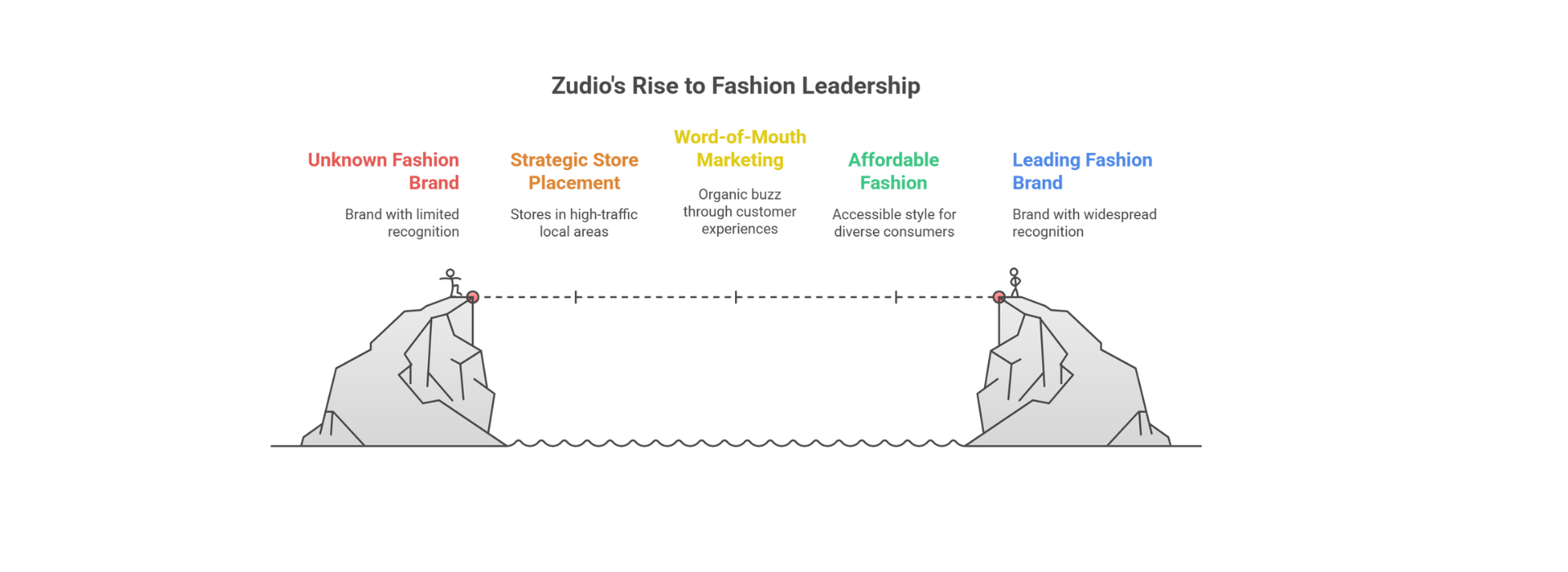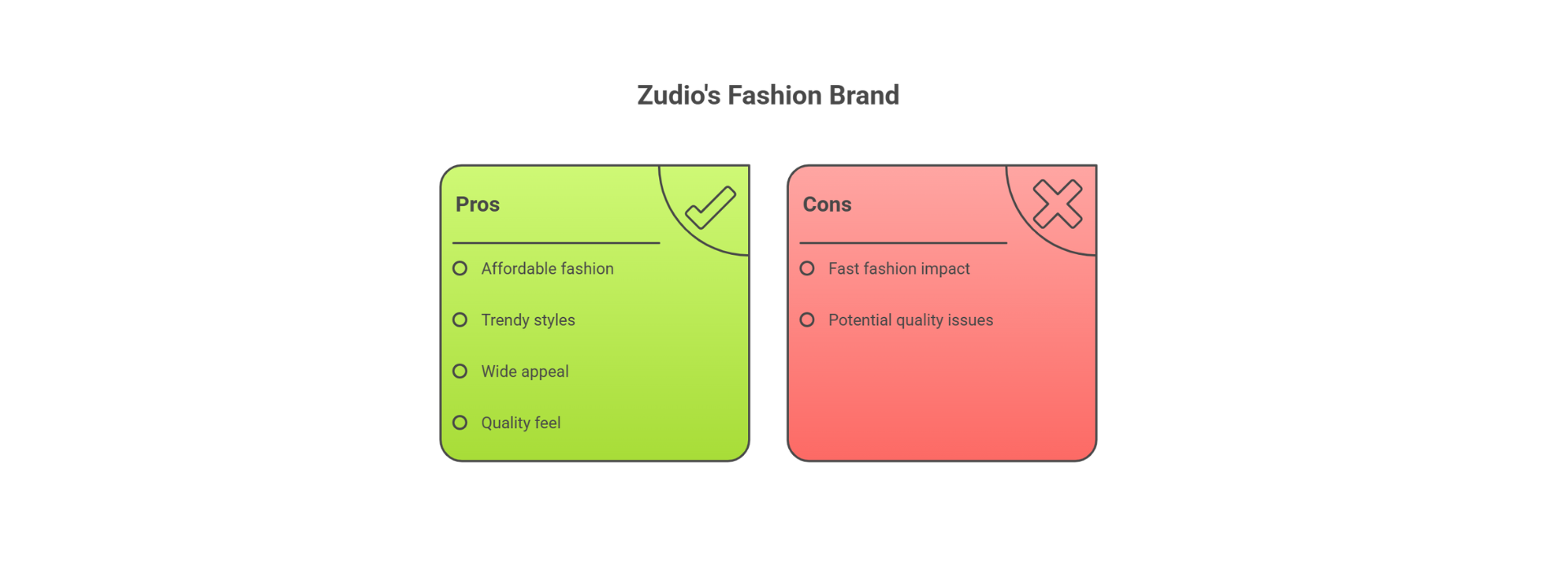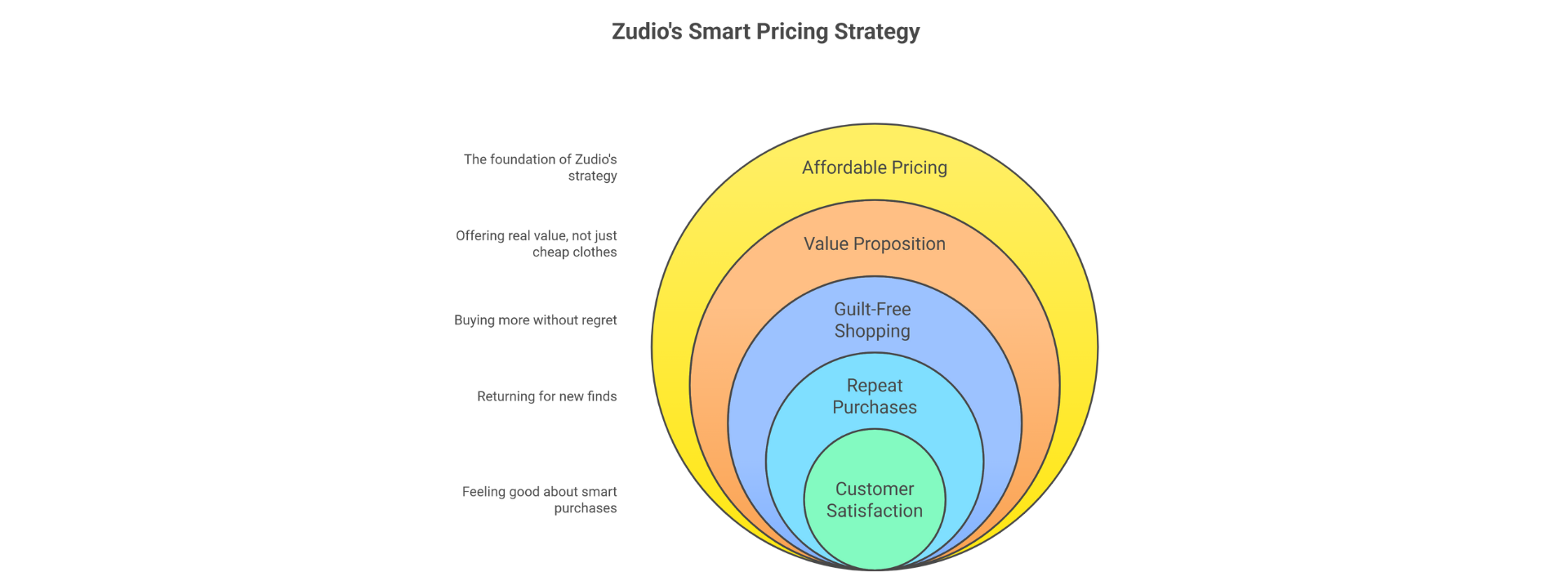
How Zudio Became India’s Fast Fashion Leader: The Strategy Behind Its Success
Hey there, fashion lovers and curious minds!
Have you ever noticed how suddenly everyone around you is talking about Zudio? From your college friends to your neighbors, it seems like this brand popped out of nowhere and took over the fashion streets of India. You’ll probably spot a Zudio store just around the corner from your home, tucked between cafes, salons, and local markets. So what’s the secret sauce?
In this blog, we’re going to dive deep into what made Zudio the fashion buzzword of the country. We’ll unpack how a brand with no celebrity backing, no flashy commercials, and no online presence managed to win the hearts (and wallets) of millions of Indians. Grab your cup of chai or coffee, settle in, and let’s explore how a simple idea turned into a nationwide trend.

What is Zudio, and Why is everyone talking About It?
Zudio is a fast fashion brand launched by the Tata Group under Trent Ltd., the same company behind Westside. But while Westside positioned itself in the premium mid-range segment, Zudio came in like a breeze—affordable, trendy, and refreshingly down-to-earth. The idea was clear: fashion doesn’t have to be expensive. It just has to feel good and look good.
Imagine walking into a store and finding a t-shirt that looks like something straight out of a Pinterest board, or a dress that screams Instagram vibes, but neither of them costs more than your weekend movie outing. That’s Zudio’s magic. And the best part? It isn’t just for one age group or gender. Whether you’re shopping for yourself, your sibling, or even your little cousin, Zudio has racks filled with styles for men, women, and kids.

Zudio Store Count in India & Global Expansion – 2025 Update
As of September 2025, Zudio has grown into one of the fastest-expanding fashion brands in India, with over 784 retail stores across 235 cities. Zudio is now present across all major city types — from Tier 1 cities (like Mumbai, Delhi, Bengaluru) to Tier 2 cities (such as Pune, Jaipur, Lucknow) and even Tier 3 towns (like Ujjain, Raipur, Jodhpur). In FY 2023–24 alone, the brand added more than 200 new stores, showing its rapid growth across India.
Zudio’s popularity comes from offering trendy and affordable fashion for men, women, and kids — making it a favorite among price-conscious yet style-loving shoppers.
Moving beyond India, Zudio took its first step into the international market in September 2024 by opening its first overseas store in Dubai, UAE, at the Silicon Central Mall. This marks the beginning of Zudio’s plans to become a global fast fashion brand.
To find the nearest Zudio store in your city or abroad, visit their official store locator.
The Numbers Behind the Buzz
Zudio isn’t just riding on word of mouth. Its growth has been staggering. With over 450 stores scattered across India, Zudio has established itself in both metropolitan cities and small towns. From Mumbai’s buzzing streets to the quieter corners of Bhubaneswar, Zudio is showing up everywhere. The brand managed to grow ten times faster than many other established players in the fashion space, all in just five years.
Now here’s something interesting: even as online shopping is booming and becoming a sign of modern lifestyle, nearly 70% of Indians still prefer shopping offline. And this is where Zudio made its move. It found its audience among people who still love the thrill of entering a store, trying out outfits, and walking out with a shopping bag in hand.
Understanding the Indian Shopper Like No One Else
Let’s be real. Indians love a good deal. Whether it’s a street vendor or a shopping mall, we’re always on the lookout for style that doesn’t burn a hole in our pockets. And Zudio tapped into this mindset perfectly. They didn’t spend crores on advertising or celebrity endorsements. Instead, they made sure their products spoke for themselves.
Their strategy was simple. Open stores where people already go to shop—like malls, local markets, and crowded high streets. And once people step in, let the pricing and the vibe of the store do the talking. It worked. The stores are spacious, easy to navigate, and filled with fresh, vibrant collections. It’s easy to walk in “just to browse” and walk out with two or three new outfits

Why an Offline-Only Model Still Works in 2025
In a world obsessed with online shopping apps and flashy e-commerce sales, Zudio decided to go the other way. They skipped the online rush entirely. You won’t find Zudio on shopping apps or websites. If you want to buy Zudio clothes, you have to walk into a store. And surprisingly, that decision has paid off big time.
Here’s why: Indian shoppers, especially those outside metro cities, still like the physical experience of shopping. They want to touch the fabric, try the fit, and see the colors in real light before they decide. Zudio gave them exactly that, without the hassle of online orders, returns, and payment issues. Plus, their beautifully designed stores, neat displays, and upbeat music turn shopping into an experience, not just a transaction.
Smart Pricing That Keeps Customers Coming Back
The most jaw-dropping part about Zudio is how affordable everything is. You walk in thinking you’ll buy just one top, and you walk out with an entire outfit. But make no mistake—Zudio is not about selling cheap clothes. It’s about offering real value.
Their pricing strategy is a masterstroke. It allows people to buy more without feeling guilty. That’s also why Zudio sees a lot of repeat customers. People come back every few weeks, knowing they’ll find something new without blowing their budget. And when they wear it, they feel good, not just because of how they look, but because they made a smart purchase.

Keeping It Fresh: Fast Fashion with an Indian Twist
Zudio is often described as a “fast fashion” brand, but it’s far more thoughtful than blindly following Western trends. The collections are updated every few weeks, ensuring there’s always something new to explore. But instead of just copying runways from Paris or Milan, Zudio takes inspiration from Indian life.
Their clothing reflects what Indian youth and families wear. From casual tees and comfy joggers to festive kurtas and Indo-Western fusion wear, the brand gets the pulse of the country right. It’s fashion that understands where you’re going—to college, to a wedding, to a dinner party, or just out on a weekend drive.
The Tata Advantage
Behind Zudio’s success is the solid backing of the Tata Group. That association gives the brand instant credibility and trust. Tata isn’t just a name—it’s a legacy. And for shoppers, knowing that Zudio is part of that legacy makes them feel confident about trying it out.
Beyond trust, Tata brings in supply chain muscle, retail experience, and the kind of infrastructure that allows Zudio to scale quickly and efficiently. That’s how they’ve managed to expand into hundreds of cities without losing consistency in their product or store experience.
Cracking the Code of India’s Smaller Cities
Most international and even Indian fashion brands usually set their sights on metro cities first. But Zudio flipped the script. Instead of only targeting Delhi, Mumbai, or Bangalore, they went for cities like Surat, Indore, Ranchi, and Guwahati.
This was a genius move. These cities are booming with young people, middle-class families, and a rising demand for affordable yet stylish clothing. Plus, the cost of running a store is much lower in these areas, and competition is less intense. Zudio didn’t just enter these markets—it owned them.
The love Zudio has received in Tier 2 and Tier 3 cities shows how powerful untapped markets can be when a brand truly understands what they need.
Word of Mouth Over Celebrity Hype
One of the most impressive things about Zudio is how they’ve built a brand without massive ad budgets. There are no famous faces telling you to shop at Zudio. Instead, the buzz comes from real people.
Shoppers share their “Zudio hauls” on Instagram and reels, friends talk about their finds, and college students show off their OOTDs (outfits of the day) proudly mentioning Zudio. This kind of organic love is priceless. It creates a genuine connection and builds loyalty far stronger than any ad ever could.
Their in-store branding also plays a big role. The color scheme, lighting, music, and layout all create a vibe that makes shopping fun. You don’t need banners screaming SALE. The store itself pulls you in.
How Zudio Stacks Up Against the Competition
If you’ve been to other fast fashion brands like H&M, Max, or Pantaloons, you’ll notice the difference immediately. Zudio doesn’t try to be premium. It tries to be personal.
The designs feel closer to home, the colors suit Indian skin tones better, and the fits seem made for the Indian body. It’s not about luxury or showing off—it’s about expressing yourself without spending big.
Even though brands like H&M bring global styles, they often miss the Indian taste. Max and Pantaloons do try to blend Indian and Western fashion, but Zudio seems to have cracked the balance just right, especially for the youth in smaller cities.
What Aspiring Entrepreneurs Can Learn from Zudio
Zudio’s story is packed with lessons. First, it proves that you don’t always need glamour or a digital-first approach to win. What you need is clarity, consistency, and a deep understanding of your customers.
By sticking to its core promise—affordable, trendy fashion for everyday Indians—Zudio avoided the noise and focused on execution. It simplified fashion, removed the frills, and made shopping fun again.
Whether you’re launching a startup, running a small business, or just dreaming about your next big idea, Zudio’s playbook is a great one to study. Focus on your audience. Deliver real value. And let your customers do the talking.
Final Thoughts: The Journey is Just Beginning
From being a lesser-known entry in Tata’s retail lineup to becoming the darling of Indian fashion retail, Zudio has come a long way—and they’re not slowing down.
They’ve turned budget shopping into a cool, stylish, and sought-after experience. In doing so, they’ve built a community of loyal shoppers who don’t just wear Zudio, they rave about it.
And that, perhaps, is the biggest win of all. Zudio didn’t just sell clothes. It created a movement. And as more cities, more people, and more stories join this journey, one thing is clear: Zudio is not just a brand—it’s a phenomenon in the making.
So the next time you see that familiar white and yellow storefront, step in. You might just walk out feeling a little more stylish and a whole lot smarter.
Frequently Asked Questions (FAQs)
1. About Zudio: What is Zudio and Its Meaning?
Zudio is a popular fashion retail brand in India, known for affordable and stylish clothing. The word Zudio itself represents trendy fashion for everyone. Many shoppers search for “what is Zudio” or “Zudio meaning,” and the answer is simple: it is Tata Group’s initiative to make fashion accessible for all.
2. Who Owns Zudio? The Parent Company Behind the Brand
Many people ask, “Who owns Zudio?” or “Is Zudio owned by Tata?” The answer is yes—Zudio is owned by Trent Limited, which is a part of the Tata Group. Trent is the parent company of Zudio, managing the brand’s rapid expansion across India. This makes Zudio not just another fast-fashion store but a trusted Tata clothing brand.
3. Zudio Owner and Brand Leadership
Although Zudio is backed by Tata, people often want to know, “Who is the founder of Zudio?” The brand was launched by Trent Ltd. under the Tata Group, with its retail strategies shaped by Tata leadership. This strong foundation ensures Zudio’s credibility and long-term growth.
4. Is Zudio a Tata Brand?
Yes, Zudio is a Tata brand. It is one of the fastest-growing retail arms under Tata Trent Ltd. Shoppers often compare Zudio with other Tata products, but what sets Zudio apart is its focus on affordable fashion with stylish collections.
5. Zudio Logo: A Symbol of Simplicity
The Zudio logo reflects the brand’s minimalistic and modern approach. Unlike many fashion brands that rely on luxury appeal, the Tata Zudio logo emphasizes accessibility, freshness, and everyday style.
6. Why Zudio is a Good Brand in India
Zudio has gained massive popularity because it offers quality clothing at affordable prices. Customers often ask, “Is Zudio a good brand?” The answer is yes—its growth across cities and small towns shows strong customer trust. Backed by Tata, Zudio stands out for its budget-friendly fashion, trendy collections, and reliable quality.
7. Who owns Zudio?
Trent Ltd., a part of the Tata Group, owns Zudio.
8. Why doesn’t Zudio sell online?
Zudio focuses on offline retail to offer better prices and an engaging in-store experience.
9. How are Zudio’s prices so low?
They save on logistics, returns, and advertising, passing the benefits to customers.
10. Where can I find a Zudio store?
Zudio has 450+ stores across metros, towns, and growing cities in India.
11. What makes Zudio different from H&M or Max?
Zudio offers lower prices, more India-friendly styles, and a strong presence in Tier 2 and 3 cities.
- Market Analysis
- Business Ideas
- Investment Ideas
- Businessman
- Business case study








